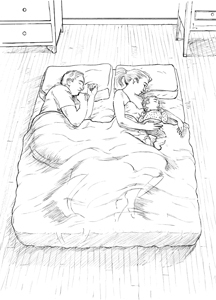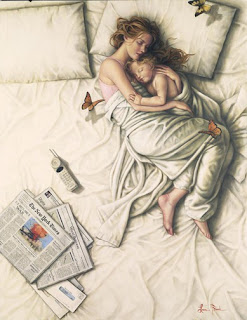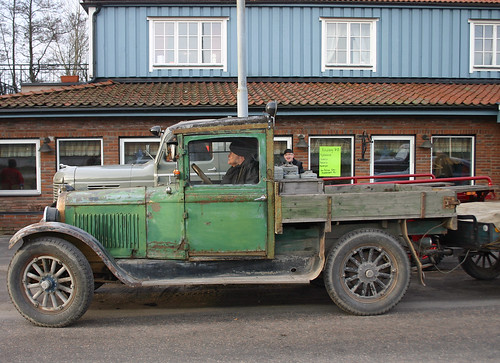- Bed-sharing is the practice of an infant sleeping in the same bed as its mother.
- Co-sleeping is the practice of an infant sleeping in the same room as its mother.
Since time immemorial, bed-sharing has been the normal practice of mothers around the world. Indeed, the majority of the world continue to practice bed-sharing. I practiced bed-sharing with all three of my now-adult children. My mother was found by a nurse with me asleep beside her in hospital. It is nothing new!
So why is it now an issue of fear-mongering from coroners and other health professionals around the world? Take, for example, this appalling poster campaign recently released in the US:
I think this is a heartless way to highlight ANY health campaign and can only imagine the outrage if such images were used to highlight the health risks of using infant formula instead of breastfeeding.
Coincidentally, just as these images were making news in the blogosphere, this equally emotive image also appeared in my news feed:
Regardless of decisions consiouslly made by parents, something like 25% find themselves sleeping with their baby at some stage. Therefore, campaigns which highlight potentially high-risk circumstances make more sense than those designed only to frighten parents. An example is the brochure "Is your baby sleeping safely?" which is available on the website of the Australian Breastfeeding Association and which I regularly give to parents seeking information at the Breastfeeding Centre where I work.
In 2010, the South Australian Coroner issued strong warnings against bed-sharing, based on a review of five cases of sudden death in infants sleeping with their parents. I sought out the report online and read it, distressing as the cases were, and discovered that 4 out of 5 cases were instances of blatantly unsafe bed-sharing practices: in fact, some involved sleeping with an infant on a couch or arm-chair, not a bed at all.
Today, the Victorian Coroner has been quoted making similar warnings.
In the first Australian study of its kind, the Victorian Coroners Prevention Unit recently found that of 72 infant deaths reported between 2008 and 2010, 33 were of babies who had slept on the same surfaces as an adult.Now, look at those numbers and imagine if that prompted a campaign against babies sleeping in cots - after all: 39 out of 72 babies were NOT sleeping in bed with their parent!
Much research has been done to demonstrate the safety of bed-sharing when practiced by breastfeeding mothers who are non-smokers and not affected by drugs or alcohol, which surely should be the standard we should be aiming for.
In fact, bed-sharing enables successful breastfeeding AND enhances safe sleeping in the infant and mother. the work of Dr James McKenna is recognised for the SAFE bed-sharing guidelines which maximise the benefits and reduce the risks. It is such guidelines that coroners and other health professionals should be highlighting:
Safe Cosleeping Guidelines
Guidelines to Sleeping Safe with Infants:
Maximizing the chances of Safe Infant Sleep in the Solitary and Cosleeping (Specifically, Bed-sharing) Contexts, by James J. McKenna, Ph.D. Professor of Biological Anthropology, Director, Mother-Baby Sleep Laboratory, University of Notre Dame.

Below I have summarized and highlight some of the issues to be concerned with as you make your own decisions about where and how your infant should sleep.
What constitutes a "safe sleep environment" irrespective of where the infant sleeps?
Safe infant sleep begins with a healthy gestation, specifically without the fetus being exposed to maternal smoke.
Post-natally safe infant sleep begins especially with the presence of an informed, breastfeeding, committed mother, or an informed and committed father.
Infants should sleep on their backs, on firm surfaces, on clean surfaces, in the absence of smoke, under light (comfortable) blanketing, and their heads should never be covered.
The bed should not have any stuffed animals or pillows around the infant and never should an infant be placed to sleep on top of a pillow.
Sheepskins or other fluffy material and especially bean bag mattresses should never be used. Water beds can be dangerous, too, and always the mattresses should tightly intersect the bed-frame Infants should never sleep on couches or sofas, with or without adults wherein they can slip down (face first) into the crevice or get wedged against the back of a couch.
Bed-sharing: It is important to be aware that adult beds were not designed to assure infants safety!
- Bottle-feeding babies should always sleep alongside the mother on a separate surface rather than in the bed.
- If bed-sharing, ideally, both parents should agree and feel comfortable with the decision. Each bed-sharer should agree that he or she is equally responsible for the infant and acknowledge that the infant is present. My feeling is that both parents should think of themselves as primary caregivers.
- Infants a year or less should not sleep with other children siblings -- but always with a person who can take responsibility for the infant being there;
- Persons on sedatives, medications or drugs, or is intoxicated - -or excessively unable to arouse should not cosleep on the same surface with the infant.
- Excessively long hair on the mother should be tied up to prevent infant entanglement around the infant's neck -- (yes, it has really happened!)
- Extremely obese persons, who may not feel where exactly or how close their infant is, may wish to have the infant sleep alongside but on a different surface.
- It is important to realize that the physical and social conditions under which infant-parent cosleeping occur, in all it's diverse forms, can and will determine the risks or benefits of this behavior. What goes on in bed is what matters.
- It may be important to consider or reflect on whether you would think that you suffocated your baby if, under the most unlikely scenario, your baby died from SIDS while in your bed. Just as babies can die from SIDS in a risk free solitary sleep environment, it remains possible for a baby to die in a risk-free cosleeping/bed sharing environment. Just make sure, as much as this is possible, that you would not assume that , if the baby died, that either you or your spouse would think that bed-sharing contributed to the death, or that one of your really suffocated (by accident) the infant. It is worth thinking about.
Aside from never letting an infant sleep outside the presence of a committed adult, i.e. separate-surface cosleeping, I do not recommend to any parents any particular type of sleeping arrangement since I do not know the circumstances within which particular parents live. What I do recommend is to consider all of the possible choices and to become as informed as is possible matching what you learn with what you think can work the best for you and your family.







